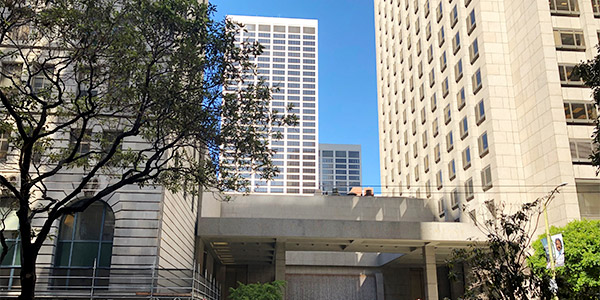Pacific Gas and Electric said it had completed its bankruptcy restructuring Wednesday, one day after California Gov. Gavin Newsom signed a bill allowing the state to take over the utility if it fails egregiously over time to obey the Public Utilities Commission’s rules.
Those rules, imposed as a condition of the commission’s decision to accept PG&E’s bankruptcy plan in May, required the utility to submit to enhanced oversight and escalating enforcement for safety failures. Repeated and uncorrected problems could let the commission appoint a third-party monitor followed by a receiver, and eventually to rescind PG&E’s license to operate as the monopoly utility for most of Central and Northern California.
If that happens, the newly enacted Senate Bill 350 authorizes the state to seize PG&E through eminent domain and transfer its operations and assets to a nonprofit public benefit corporation called Golden State Energy, created by the legislature and governor.
“The purpose of this division is to ensure that if Pacific Gas and Electric Co. fails to emerge from bankruptcy as a transformed utility, then Golden State Energy is duly empowered to serve in that critical role,” the new law says. “It is the intent of the legislature that Golden State Energy act pursuant to this division only in the event that a transformed utility does not emerge from the bankruptcy or the transformed utility fails to meet its duty to provide safe, reliable and affordable energy services.”
Some critics have contended the CPUC’s six-step process of punishing PG&E would take so long that a takeover won’t happen. Dozens of public speakers urged the commission to yank PG&E’s license immediately prior to its approval of the utility’s reorganization plan May 28.
“We need a public utility,” one that’s not motivated by profits to forgo safety upgrades and maintenance, San Francisco Bay Area resident Charlotte Quinn told commissioners.
Newsom said in a statement Tuesday, however, that his signing of SB 350 means there will be “no more business as usual for PG&E.”
“As we head into wildfire season amid a pandemic, Californians need to have confidence that their utility is focused on customer safety, preventing wildfire[s] … and making critical safety upgrades,” the governor said. “SB 350 marks a critical step in the transformation of PG&E into a utility that is accountable to those it serves.”
The measure authorizes the state to sell bonds to finance the purchase of PG&E. It cleared the State Senate on Monday and went to Newsom for his signature.
Bill author Sen. Jerry Hill (D) has called the measure a “plan B” if PG&E doesn’t undergo the safety transformation it has promised. (See Plan B for PG&E Takeover Moves Forward.)
“As much as we push forward with that change, we must also be prepared to step in should the company not meet its obligations or commitments in the future,” Hill told the State Assembly’s Utilities and Energy Committee last month. “SB 350 is our preparation. I hope it’s unnecessary and that it’s never triggered, but we owe this preparation to the residents of San Bruno and Santa Rosa and Napa and Butte County and Paradise.”
Those communities were devastated by PG&E-caused catastrophes in the past decade.
The Camp Fire, the state’s deadliest and most destructive wildland blaze, wiped out most of the town of Paradise on Nov. 8, 2018, killing 85 residents and destroying more than 14,000 homes. The wine country fires of October 2017 ravaged the city of Santa Rosa and large areas of Napa and Sonoma counties. A gas pipeline explosion in September 2010 killed eight people and destroyed part of a residential neighborhood in San Bruno, a San Francisco suburb.
An estimated $30 billion in liabilities for the fires of 2017 and 2018 caused PG&E to seek bankruptcy protection in January 2019.
‘One Step Closer to Getting Paid’
PG&E said Wednesday it had emerged from that bankruptcy after nearly 18 months by obtaining the debt-and-equity financing it needed to fund $25.5 billion in settlements with fire victims, government agencies, insurance companies and the hedge funds that bought up billions of dollars in insurance subrogation claims.
U.S. Bankruptcy Judge Dennis Montali approved PG&E’s Chapter 11 plan on June 20, less than a day after it pleaded guilty to 84 charges of involuntary manslaughter in the Camp Fire. (See PG&E Sentenced; Bankruptcy Plan Approved.)
“Today’s announcement is significant for PG&E and for the many wildfire victims who are now one step closer to getting paid,” acting CEO Bill Smith said in a news release. Smith replaced former CEO Bill Johnson, who retired Tuesday.
“Compensating these victims fairly and quickly has been our primary goal throughout these proceedings, and I am glad to say that today we funded the fire victim trust for their benefit,” Smith said.
PG&E plans to fund the victims’ trust with $6.85 billion in cash in three installments through 2022 and with stock shares equal to a 22% stake in the utility, the largest electric provider in North America.
The company also said it had seated a mostly new 14-member board of directors and paid its $5 billion contribution to the state’s wildfire insurance fund, created under last year’s Assembly Bill 1054. (See PG&E Names New Board of Directors.)
Under the legal doctrine of “inverse condemnation,” California holds utilities strictly liable for fires sparked by their equipment. The $21 billion fund, to be paid for equally by ratepayers and utilities, provides financial protection against devastating blazes going forward.




